Culture War
By:
December 28, 2015
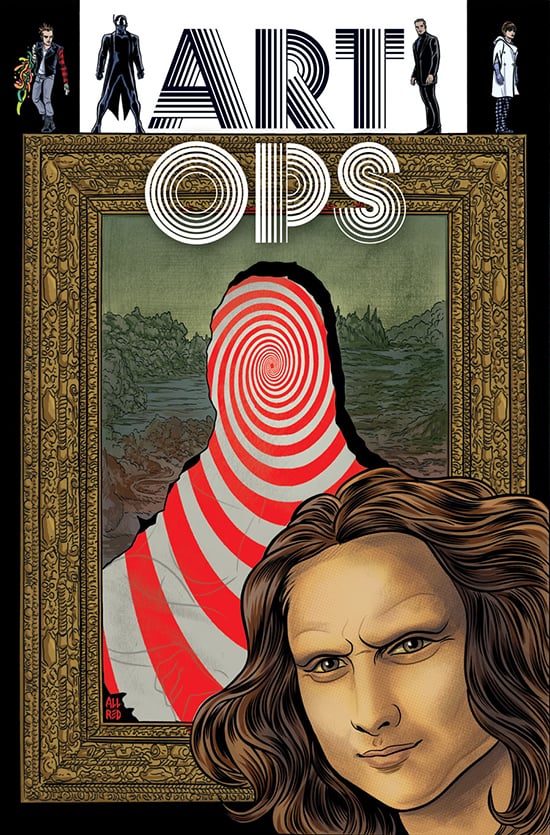
Adam McGovern speaks with mad-genius Michael Allred, one half of the hive-mind behind Vertigo’s ART OPS.
We fear the shadowy authorities above us but we fantasize about little people we can’t see. From childhood on, we envision (and are told stories of) elves who make our toys, and we joke about tiny workers inside our miraculous electronics — while trying not to know about the faroff workshops such things really come from — but think our own creations come straight from within us. All art of course is an unacknowledged group effort too — the others who have influenced us, the ideas we’re brought up to assume. ART OPS is a new Vertigo comic — or perhaps self-aware subtextual narrative stream — about supernatural, secret-agenty figures who read the clues in the semiotic urban jungle of signs and police the traffic of thoughts. Created by writer Shaun Simon (collaborator with Gerard Way and Becky Cloonan on the lysergic, prophetic The True Lives of the Fabulous Killjoys) and artist Michael Allred (pop-artiste par excellence on X-Statix, Silver Surfer and his own Madman), ART OPS decodes the web of meaning in an era whose society expresses itself more than ever, and may be understanding itself less and less. Between Dec. 18 and 24, 2015, Allred and I sent each other signals on the tapestry that ART OPS tracks and the threads its creators follow into their maze of imagery and narrative…
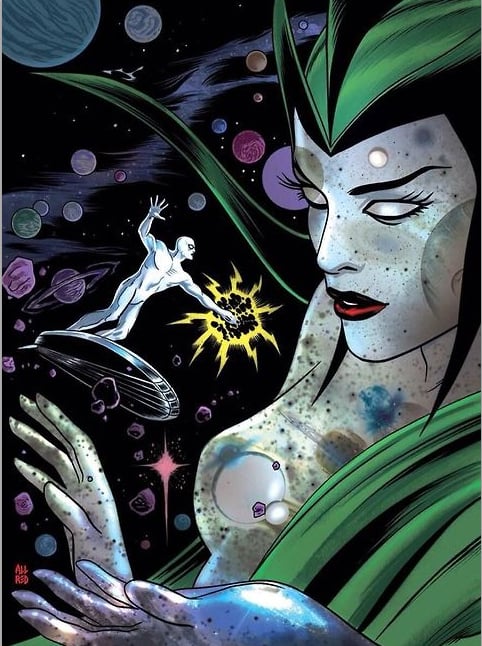
HILOBROW: The displayed environment, so to speak, is in a fundamental battle to get people’s attention and allegiance — marketing becomes more and more responsive to and anticipatory of consumers’ reactions and desires, and art struggles to be heard and seen through more media than ever existed. ART OPS takes this to a level of almost primal struggle, with popular consciousness infected Orson Welles-like by certain mass messages gone wrong, and the timestream of art messed with in ways that scramble the contexts we come to feel comfortable with (like the Mona Lisa being physically kidnapped from out of her frame and used to forward various cultural movements’ self-image). Is the world of ideas always a Darwinian battleground, or just a primeval garden that needs to be kept untouched?
ALLRED: I feel the world of ideas desperately needs to be touched. I think technology is giving people more and more access to creativity. To be artists. Even if it’s just posting photographs on Facebook. Everyone in the world is now a photojournalist, if not an artist. Marketing becomes easier for the layman as well. Every musician their own record label. Every storyteller their own entry-level publisher. So ideas are more easily expressed. Again on an entry-level basis. When it comes to art, what art actually IS becomes WAY harder to define. You and I both have had varying degrees of success in getting our art noticed. Some art connects with bigger audiences than others. But any artist can have a diehard fan base of one to a billion. Success becomes relative. Numbers. Money earned. Critical acclaim. And now the phrase “everyone is a critic” has never been truer.
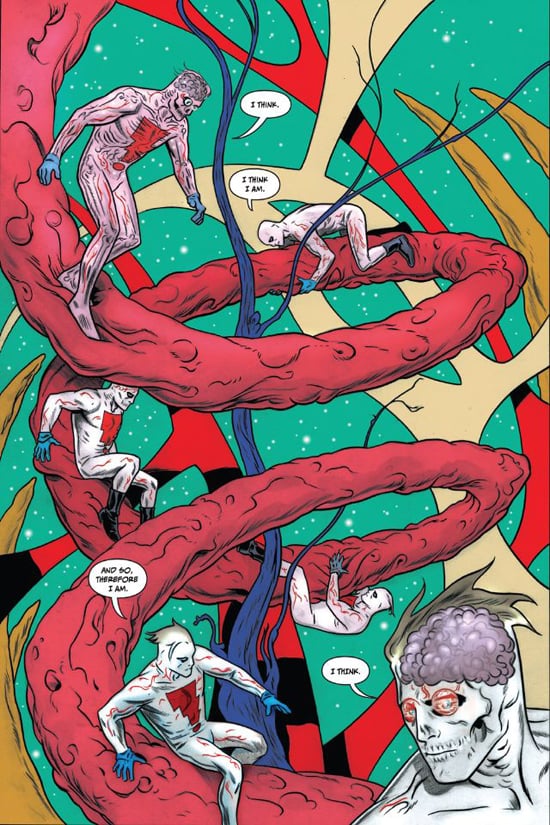
HILOBROW: There are more and more comics about characters who are self-aware that they are narrative constructs, but still follow the thrust of complicatedly good yarns (Morrison’s The Multiversity and the last four years of Marvel’s Loki comics being just two of many examples). As far back as Kirby’s space-god comics, pop had the idea that “gods” and other superlative beings take form from a convergence of mortals’ collective hopes and ideals — and ART OPS extends this to posit that ideas themselves have an inherent life. Does this correspond with the recent quantum theories that even inanimate objects may have some low frequency of consciousness?
ALLRED: Sure it does. And may explain why we project life into objects. Our toys are alive to us when we are children. Fictional characters are precious. Alive. Real. Places often give a sense of those who’ve been there. Do we leave bits of our souls everywhere we go? It’s not a big stretch to look at a painting or sculpture and project life into it. Life that the creator/artist injected into it, and [that] those who view it [did]. The way an observer is pulled into a film and reacts to something that isn’t real.
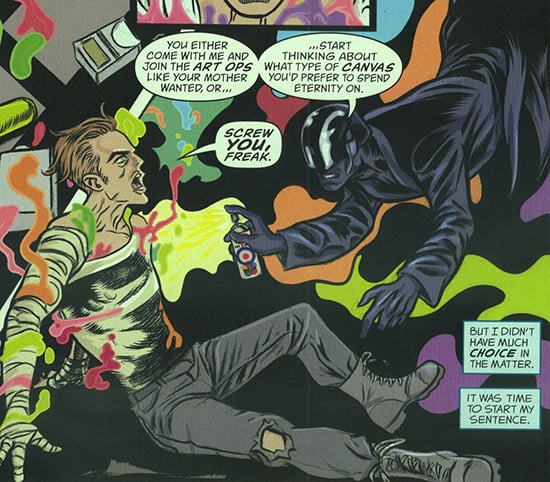
HILOBROW: Given that we tend to think semiotically of works of art and other expression being possessed by whatever meanings people of different eras project onto them, what makes an idea take on a life of its own?
ALLRED: That’s the big question. Where does an idea come from? Is the idea itself the soul or heartbeat that gives art life? How is it nurtured into something relevant? And how do we increase that relevance into an energy that generates success, word of mouth, critical acceptance? When is an audience big enough to establish something’s significance?
The more viewers a piece of art has, the more it can be discussed from ever-increasing points of view. Enthusiasm is generated and the art takes on a life of its own. Yet interpreted differently by each individual based on their life experiences and tastes. As artist/creators, we take an idea and nurture it to please ourselves, injecting life into it. Then we hope to reach people, beyond our own creative satisfaction. As an act of expression, a reaching out, a desire to move, entertain, enlighten, inspire, thrill. And then a hope of commercial success so we can sustain our lives, leave something of ourselves, evidence of our existence, our life force. All of this injects a kind of energy, or life, into the creation.
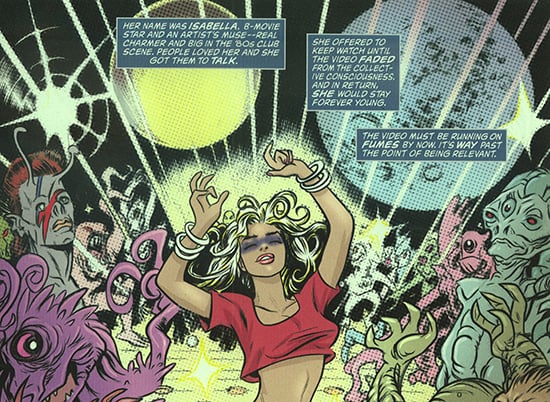
HILOBROW: The idea of an elite corps of protectors patrolling our shared consciousness goes back at least as far as Simon & Kirby’s early-1970s Sandman — and I guess at least as far back as Biblical angels. What is the relationship of those imaginative people who create, and those imagined figures who moderate how far our minds go?
ALLRED: The relationship is probably interchangeable. I want to go deep into the written word as art here. The Bible is among the oldest, if not the oldest piece of protected art. Scriptures in general are organic and ever-changing. Full of metaphorical fictional personages, as well as supposedly historical lives lived. Over centuries, so-called caretakers have removed, replaced, redefined, reinterpreted, added, and subtracted passages. That’s historical fact. The Old Testament in particular is arguably (and people love to argue) a bit of a mess. To fundamentally believe that every word is the perfect word of God is a dangerous and naive position to take. Which version is the perfect one? Which language? Yet billions of people have dedicated their lives to what they have read or been taught about the scriptures. Most reading or learning it piecemeal. Many sticking to innocent childhood Bible stories without complete or accurate context.
How many people love the story of, and take inspiration from, young David who bravely slayed the big bad giant? How many continue to admire the same David, as King, who murders a man, intentionally sends a man to his death so he can have his lusted-after wife? Great drama. But not an example of an inspiring life to emulate. Great songwriter, David, but ended his life as a bit of a scumbag.
Was this fiction? Did he really exist? Was his life story completely fabricated? Was there a giant? What “caretaker” enhanced/embellished his biography? What caretakers protected the absolute truth of it and other Bible stories? What was changed to meet the times of each new edition? What was the mindset or motivation of each editor? How skilled was each author who contributed to the parchments?
Did Moses literally part the Red Sea? Or was he lucky with a drought and a flash flood? Was the entire Earth literally covered by water, leaving Noah and company the only survivors on the whole planet? Or did a little embellishment take place here and there over the centuries for the sake of art and storytelling? Jonah surviving in the belly of a great fish? God telling a father to stab his own kid to see how obedient he is? I’d love to see that hold up in court. How often does the “God told me to do it” defense work out?
Great stories! Is it art? Is it literal? Is it alive? And what’s all the gobbledygook of rules for what-ya-can and what-ya-can’t do? “Cuz i said so.” That’s incredible power! That’s the stuff that controls and takes lives.
Is it art? They are words on paper. They inspire and motivate. And they confuse. They defy reason. They challenge faith. They stir to anger. They bring souls to weeping. Words on parchment printed and re-interpreted century after century with no one agreeing on absolutely everything contained therein.
Now, let’s jump ahead to the recent century and take a look at The Da Vinci Code. There are people who think that work of fiction is packed with well-researched fact. Scientology? L. Ron Hubbard wrote science-fiction. Fiction that created a recognized tax-exempt religion. Let’s go back just a couple centuries with The Book of Mormon? I love it! Inspired a great musical! If true, then a lost record of a thousand-year period between 600 BC and 400 AD revealed to the world proving that Christ came to the Americas as a resurrected being. If fiction, then some powerful storytelling there by a great artist. Some would say “con” artist.
I feel that anyone who doesn’t open their mind to the possibility that all scriptures of every faith are imperfect, if not outright fictional, are doing themselves a disservice. IF you take the leap of faith that something is true and worthy of your devotion, then it should also be able to take the “stress test.” If God exists and gave us brains to utilize intelligence then we absolutely should use that intelligence to its fullest and always question what is true, what is art, and can something true also be art? The [concept] of “what is art” is almost too broad to be defined.
And that brings me back to art in general. If I project life into an inanimate object, I should know that I am creating a fantasy world through that projection. But with intelligence and an open mind, I should also stretch the idea of possibilities beyond my current understanding. At least on an artistic level. But until science or researched fact proves something to be true, we must recognize art as art, and the written word as fiction, the creation of mankind.
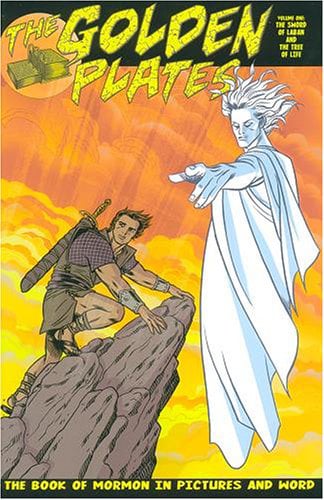
HILOBROW: So, contrary to the way we’re often told there are “no right answers” to what a work of art means, is there a right action to be taken with a creative work’s interpretation in ART OPS? Our “heroes” stand guard over how art is used and how its suggestions influence people. Are they the spirit of authority, making sure that, while anyone can be an artist, not everyone can be a critic? An infallible personification of the creative principle (or at least the patronage principle), or an embodiment of the declining elite that prescribes people’s tastes, the filter that tells people what to like and how? Free will and the observed’s right to their own self-concept (Michelangelo’s David, the Statue of Liberty, etc. being resculpted and redefined against their choice) are major thematic motifs in ART OPS’ story…
ALLRED: Our “heroes” are far from perfect, and while they believe their mission is to protect art, I think what they and the readers will discover, or at least contemplate, is that they aren’t equipped or even worthy to be so-called protectors. Maybe even that art doesn’t need protecting or policing in the first place. And that tastemakers should always be challenged.
Art is always dependent on the viewer. Even when a work is decreed valuable or priceless, each viewer from expert to layman still makes a personal assessment. Joe Shmoe living in the back woods probably doesn’t care one little bit about the Mona Lisa on an artistic level. If I’m Joe Shmoe, the only reason I would want a valuable piece of art that meant nothing to me would be to sell it to get something practical or something that did hold a personal value, and I’d likely have a lot of money left over. I have art that is relatively worthless to most of the world, but I would never part with it because it means so much to me.
That is my “right answer” — it’s all relative, despite an overall agreement of something’s worth. Ultimately, each person must decide what each creative act means to them.
Criticism offers a discussion; it inspires insight, even enthusiasm. Discussion can educate or excite someone into appreciating something that would have otherwise been ignored. The all-powerful “word of mouth.” It can even take away interest and passion when you realize something is not what you thought it was. A new perception, appreciation, or realization is a kind of “resculpting.” We each only know, determine, and perceive existence through our own eyes. Outside influences and experience sculpt our tastes.
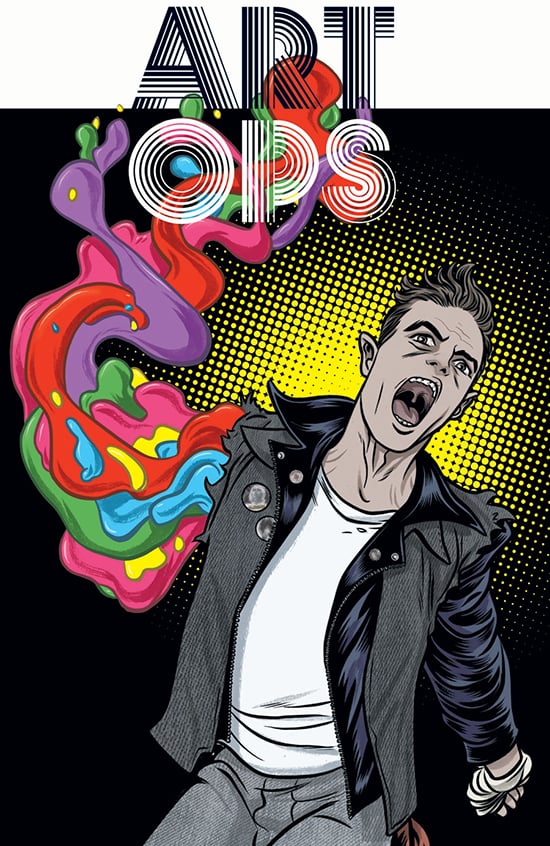
HILOBROW: ART OPS lets you revel in your affection for midcentury fashion and design — has that set in for good as the classical period of postmodernism, the old-master canon of pop culture? In a book where half-millennia-old paintings are coveted contraband of cosmic significance, it’s an even more intriguing question…
ALLRED: For me, it probably has. And [is] probably the trunk of the tree to what most would define as postmodernism. It’s where and how everyone branches out from there that hints to where we’re going.
